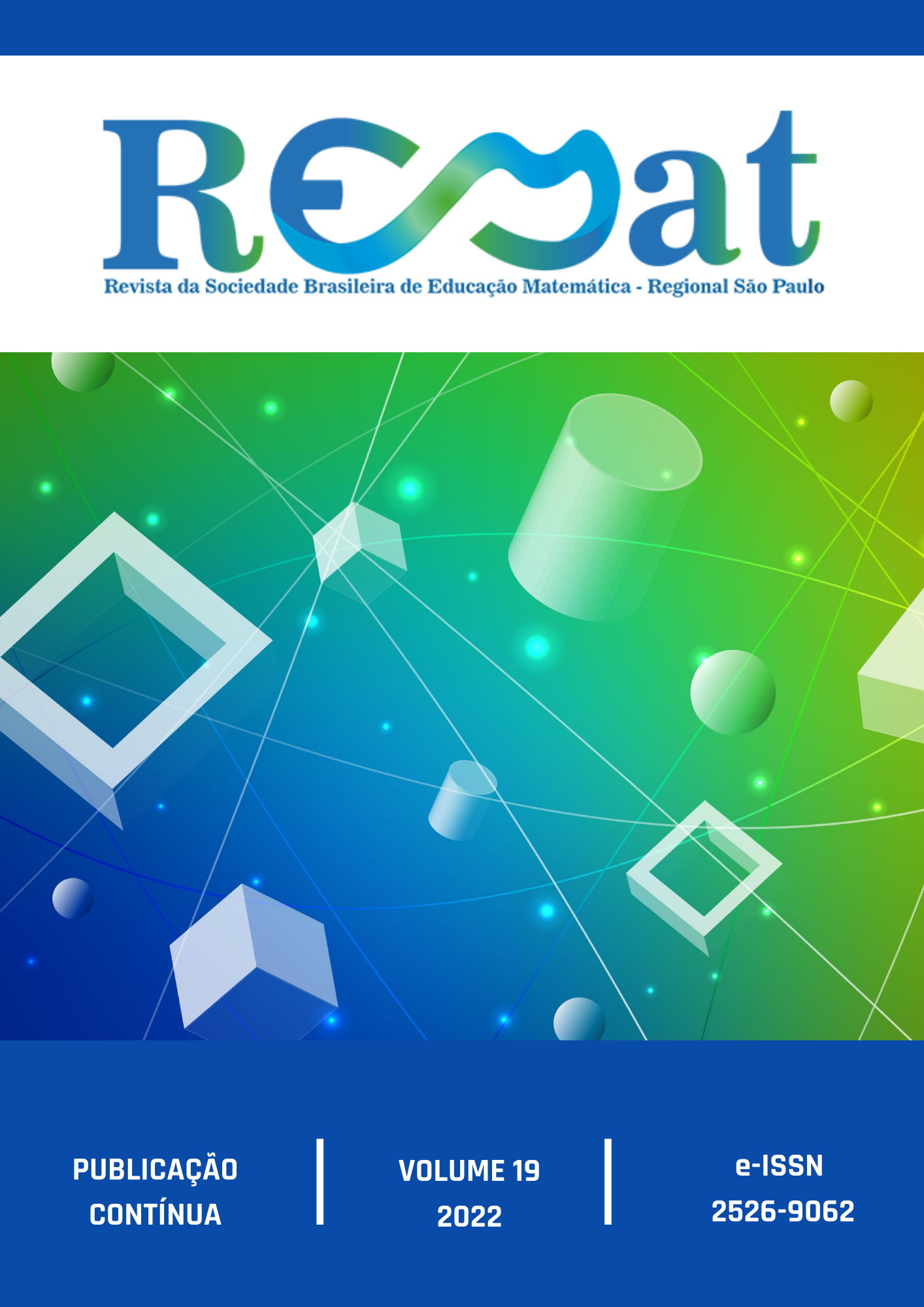The influence of the use of Origami in the development of Geometric Thought: a look from the Israel Origmetry Program
DOI:
10.37001/remat25269062v19id671Keywords:
Geometric Thinking, Origami, OrigometricsAbstract
This article is originated from a Master's in Mathematics Education research funded by the National Council for Scientific and Technological Development of Brazil (CNPq) and presents perspectives on Geometric Thinking and the use of Origami for its development through the presentation of an excerpt of current academic works on the theme and the analysis of the didactic-pedagogical strategies implemented with children from 4 to 8 years old under the Israel Origametria Program. As the main result presented, we highlight the importance of teaching and learning environments that aim to provide the development of Geometric Thinking to articulate different models of cognitive development and the possibility of Origami being able to contribute to this.
Downloads
Metrics
References
BURGER, W. F. & SHAUGHNESSY, M. Characterazing the van Hiele Levels of Development in Geometry. Journal for Research in Mathematics Education. 1996. pp. 31-48. Disponívelem: <http://citeseerx.ist.psu.edu/viewdoc/download?doi=10.1.1.584.2471&rep=rep1&type=pdf >. Acesso em 09 10 2021
CEIA, M. J. M. A Taxonomia SOLO e os níveis de Van Hiele. Comunicação apresentada no XI Encontro de Investigação em Educação Matemática. Coimbra: 2002. Disponível em: <https://www.researchgate.net/publication/237709095_A_taxonomia_SOLO_e_os_niveis_de_van_Hiele> Acesso em 09 10 2021
COSTA, A. P. Pensamento Geométrico: em busca de uma caracterização à luz de Fischebein, Duval e Pais. Revista Paranaense de Educação Matemática. PR, Brasil, v.09, n.18, pp. 152-179, jan-jun, 2020. Disponível em: <http://revista.unespar.edu.br/index.php/rpem/article/view/651/550> Acesso em: 09 10 2021
FRIEDMAN, M. Mathematical Recreational Folding in the 20Th Century: Between Row and Gardner. In: LANG, R. J.; BOLITHO, M.; YOUT, Z.; BOAKES, N.; BUDD, C.; CHEN, Y.; FRECKER, Y.; MITANI, J.; PARDO, J.; PAULINO, C.; SCHENK, M.; TACHI, T.; UEHARA, R.; WANG-IVERSON, P. (Eds.) The Proceeding from the 7th International Meeting on Origami in Science, Mathematics, and Education: Vol 1: Design, Education, History and Science, pp. 165-180, Holywell Hill, Irlanda, Tarquin, 2018
GOLAN, M & JACKSON, P. Origametria: A Program to Teach Geometry and to Develop Learning Skills Using the Art of Origami.In: LANG, R. J. (Ed.) ORIGAMI4: FOURTH INTERNATIONAL MEETING OF ORIGAMI SCIENCE, MATHEMATICS AND EDUCATION. Boca Raton, Florida: CRC Press, Taylor & Francis Group, pp. 459-469, 2009
GOLAN, M & OBERMAN, J. The Kindergarten Origametria Program. In: MIURA, K., KAWASAKIM T. & IVERSON-WANG, P. (Eds.). ORIGAMI6:PROCEEDINGS OF THE SIXTH INTERNATIONAL MEETING ON ORIGAMI SCIENCE, MATHEMATICS AND EDUCATION. American Mathematical Society, pp. 669-678, 2015
GOLAN, M. Origametria and the van Hiele Theory of Teaching Geometry. In: IVERSON-WANG, P, LANG, R. J. & YIM, M. (Eds.). ORIGAMI5:FITH INTERNATIONAL MEETING OF ORIGAMI SCIENCE, MATHEMATICS, AND EDUCATION. Boca Raton, Florida: CRC Press, Taylor & Francis Group, pp. 151-164, 2011
HATORI, K. Historiy of Origami in the East and the West before Interfusion. In: IVERSON-WANG, P, LANG, R. J. & YIM, M. (Eds.). ORIGAMI5:FITH INTERNATIONAL MEETING OF ORIGAMI SCIENCE, MATHEMATICS, AND EDUCATION. Boca Raton, Florida: CRC Press, Taylor & Francis Group, pp. 3-11, 2011
KLEMER, A.; RAPOPORT, S. Origami and GeoGebra Activities Contribute to Geometric Thinking in Second Graders. EURASIA Journal of Mathematics, Science and Technology Education, 16(11), 2020 Disponívelem: < https://www.ejmste.com/download/origami-and-geogebra-activities-contribute-to-geometric-thinking-in-second-graders-8537.pdf>Acessoem: 09 10 2021
MENEZES, D. B. & NETO, H. B. Pensamento Matemático Avançado: Origem e Características. Boletim Cearense de Educação e História da Matemática, 04, nº10, pp. 26-35, 2017 Disponível em: <https://revistas.uece.br/index.php/BOCEHM/article/view/45/49> Acesso em: 09 10 2021
MONTEIRO, L. C. N. Origami: história de uma geometria axiomática. Dissertação apresentada na Universidade de Lisboa para a obtenção do grau de Mestre em Matemática para o Ensino, 2008 Disponível em: <https://repositorio.ul.pt/> Acesso em 09 10 2021
NASCIMENTO, E. C. O Desenvolvimento do Pensamento Geométrico, Interação Social e Origami .XII Encontro Nacional de Educação matemática, Cultura e Diversidade, São Paulo, SP, pp. 1-12, julho de 2016. Disponível em <http://www.sbem.com.br/enem2016/anais/pdf/5410_2560_ID.pdf> Acesso em: 09 10 2021
PEGG, J., DAVEY, G. Interpreting Student Understanding in Geometry: A Synthesis of Two Models. In: LEHRER, R., CHAZAN, D. (Eds) Designing Learning Environments for Developing Understanding of Geometry and Space, pp. 130-132, New York, Routledge, Taylor & Francis Group, 1998
PEGG, J.; TALL, D. The Fundamental Cycle of Concept Construction Underlying Varios Theoretical Frameworks. IN: SRIRAMAN, BHARATH; ENGLISH, LYN, (orgs.) Advances in Mathematics Education: Theories of Mathematics Education: Seeking New Frontiers, Berlin, Springer-Verlag, pp.171-192, 2010
SCHOENFELD, A. H. Mathematical Problem Solving. Orlando, Academic Press, 1985
TUBIS, A.; WANG-IVERSON, P. Froebel's Views no the Role of Paper Folding in Early mathematics Education. In: LANG, R. J.; BOLITHO, M.; YOUT, Z.; BOAKES, N.; BUDD, C.; CHEN, Y.; FRECKER, Y.; MITANI, J.; PARDO, J.; PAULINO, C.; SCHENK, M.; TACHI, T.; UEHARA, R.; WANG-IVERSON, P. (Eds.) The Proceeding from the 7th International Meeting on Origami in Science, Mathematics, and Education: Vol 1: Design, Education, History and Science, pp. 181-195, Holywell Hill, Irlanda, Tarquin, 2018
VAN HIELE, P. Structure Insight: A Theory of Mathematics Education. New York, Academic Press, 1986
Downloads
Published
Métricas
Visualizações do artigo: 158 PDF (Português (Brasil)) downloads: 101
How to Cite
Issue
Section
License

This work is licensed under a Creative Commons Attribution-NonCommercial-NoDerivatives 4.0 International License.


 Português (Brasil)
Português (Brasil)
 Español (España)
Español (España)
 English
English






































